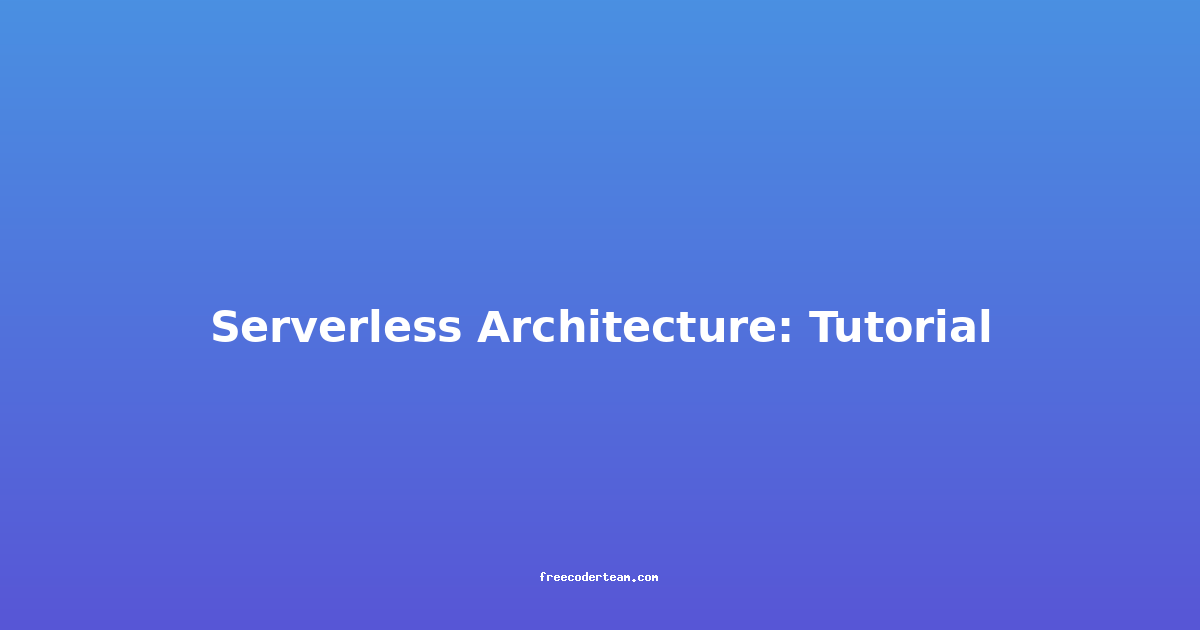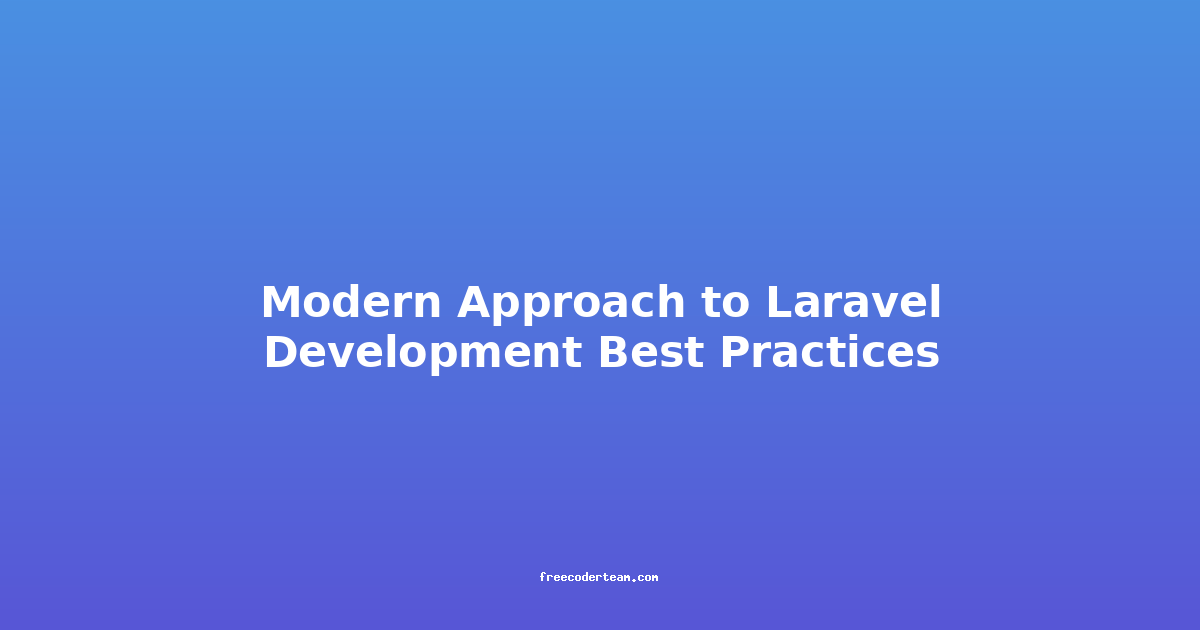Essential Serverless Architecture: A Comprehensive Guide
Serverless architecture has revolutionized the way we build and deploy applications, offering significant advantages in scalability, cost-efficiency, and developer productivity. In this blog post, we'll explore the core concepts of serverless architecture, its benefits, practical examples, best practices, and actionable insights to help you leverage its power effectively.
What is Serverless Architecture?
Serverless architecture is a cloud computing model where the cloud provider dynamically manages the allocation and scaling of resources. Instead of managing servers or virtual machines, developers focus on writing and deploying code, while the cloud provider handles infrastructure management, auto-scaling, and resource allocation.
Key components of serverless architecture include:
- Functions-as-a-Service (FaaS): Executable code that runs in response to events, such as HTTP requests or data changes.
- Backend-as-a-Service (BaaS): Pre-built services for common functionality like databases, authentication, and storage.
Core Benefits of Serverless Architecture
1. Scalability
Serverless applications automatically scale up or down based on demand. This eliminates the need for manual scaling and ensures optimal resource utilization.
2. Cost Efficiency
You only pay for the compute resources consumed by your application. There are no costs for idle resources, making serverless a cost-effective solution for variable workloads.
3. Reduced Operational Overhead
With serverless, you don't need to manage servers, patches, or updates. The cloud provider handles all infrastructure management, allowing you to focus on business logic.
4. Rapid Deployment
Serverless functions can be deployed quickly without worrying about server configuration or infrastructure setup.
Practical Examples of Serverless Architecture
Example 1: Image Resizing Microservice
Imagine building a microservice that resizes images uploaded by users. In a traditional setup, you'd need to manage a server to handle the resizing tasks. With serverless, you can leverage AWS Lambda or Azure Functions to run the resizing code in response to events, such as an image being uploaded to an S3 bucket.
Code Example (AWS Lambda in Python):
import boto3
import os
from PIL import Image
def resize_image(event, context):
# Get the S3 bucket and key from the event
bucket = event['Records'][0]['s3']['bucket']['name']
key = event['Records'][0]['s3']['object']['key']
# Download the image from S3
s3 = boto3.client('s3')
temp_file = '/tmp/image.jpg'
s3.download_file(bucket, key, temp_file)
# Resize the image
image = Image.open(temp_file)
resized_image = image.resize((200, 200))
resized_image.save(temp_file)
# Upload the resized image back to S3
resized_key = f'resized/{key}'
s3.upload_file(temp_file, bucket, resized_key)
return {
'statusCode': 200,
'body': f'Resized image uploaded to {bucket}/{resized_key}'
}
How it Works:
- An image is uploaded to an S3 bucket.
- The S3 bucket triggers an event.
- The event invokes the AWS Lambda function, which processes the image and uploads the resized version back to S3.
Example 2: Real-Time Data Processing
Serverless is ideal for real-time data processing, such as analyzing sensor data from IoT devices. For instance, you can use Google Cloud Functions to process sensor data as it arrives and store the results in a database.
Code Example (Google Cloud Function in Node.js):
const { BigQuery } = require('@google-cloud/bigquery');
exports.processSensorData = async (req, res) => {
const bigquery = new BigQuery();
// Get sensor data from the request
const sensorData = req.body;
// Insert data into BigQuery
const datasetId = 'sensor_data';
const tableId = 'readings';
const rows = [
{
device_id: sensorData.device_id,
timestamp: new Date().toISOString(),
temperature: sensorData.temperature,
humidity: sensorData.humidity
}
];
try {
const [job] = await bigquery.insert(rows, datasetId, tableId);
res.status(200).send(`Data processed successfully. Job ID: ${job.id}`);
} catch (error) {
res.status(500).send(`Error processing data: ${error.message}`);
}
};
How it Works:
- Sensor data is sent to the Google Cloud Function via an HTTP request.
- The function processes the data and inserts it into a BigQuery table for storage and analysis.
Best Practices for Serverless Architecture
1. Design for Concurrency
Serverless functions are designed to handle concurrent requests. Ensure that your code is thread-safe and avoids shared state. Use local variables and avoid global variables whenever possible.
2. Optimize Cold Starts
Cold starts occur when a new instance of your function is initialized for the first time. To minimize cold starts:
- Use provisioned concurrency (available in AWS Lambda).
- Keep function code small to reduce initialization time.
- Use a warm-up mechanism to keep functions active.
3. Monitor and Optimize Costs
Serverless billing is based on the duration of function execution. Monitor function usage and optimize for shorter execution times:
- Use asynchronous programming where possible.
- Break large tasks into smaller functions to reduce execution time.
4. Implement Retry Logic
Serverless functions can fail due to transient errors. Implement retry mechanisms using exponential backoff to handle failures gracefully.
5. Use Event-Driven Architectures
Leverage event-driven patterns to trigger functions based on specific events, such as file uploads, database changes, or API requests. This decouples components and improves scalability.
6. Leverage BaaS for Common Tasks
Use Backend-as-a-Service (BaaS) for common tasks like authentication, database management, and storage. Services like Firebase or AWS Amplify can significantly reduce development effort.
Actionable Insights
1. Choose the Right Use Cases
Serverless is ideal for event-driven applications, microservices, and applications with variable workloads. However, it may not be suitable for long-running processes or applications that require low-latency responses.
2. Start Small
Begin with simple functions and gradually expand your serverless architecture. This approach helps you understand the benefits and limitations of the model.
3. Leverage Cloud Provider Features
Each cloud provider offers unique features for serverless. For example:
- AWS: Lambda, API Gateway, DynamoDB.
- Google Cloud: Cloud Functions, Firestore, Pub/Sub.
- Azure: Azure Functions, Cosmos DB, Event Grid.
4. Test and Monitor
Implement robust testing and monitoring practices to ensure your serverless functions are reliable. Use tools like AWS CloudWatch, Azure Monitor, or Google Cloud Monitoring to track performance and errors.
5. Embrace Serverless Frameworks
Use frameworks like Serverless Framework, SAM (AWS Serverless Application Model), or Apex to simplify deployment and management of serverless applications.
Conclusion
Serverless architecture offers a powerful way to build scalable, cost-effective, and maintainable applications. By focusing on core business logic and leveraging the infrastructure managed by cloud providers, developers can deliver solutions faster and with fewer operational overheads.
Whether you're processing real-time data, building microservices, or handling file uploads, serverless is a versatile model that can transform how you approach application development. Embrace its strengths, follow best practices, and continuously monitor and optimize your serverless applications to unlock its full potential.
By adopting serverless architecture thoughtfully, you can build applications that are not only efficient and scalable but also align with modern cloud-native principles. Happy serverless coding! 🚀
References:




